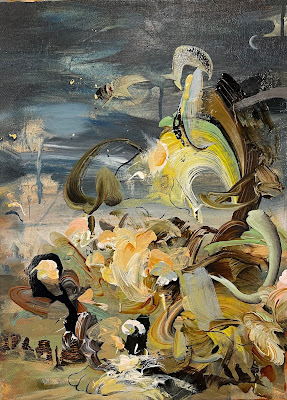Visit to the National Gallery, Winslow Homer: Force of Nature

Winslow Homer, 'The Gulf Stream', 1899 (reworked by 1906). The Metropolitan Museum of Art, New York.
I recently visited London and went to see the Winslow Homer: Force of Nature Exhibition at the National Gallery. The exhibition was organised by the National Gallery and The Metropolitan Museum of Art, New York.
I did not know much about Winslow Homer (1836–1910) the well-known American Realist painter prior to my visit. The paintings gave an overview of his work in chronological order and depicted some of the leading issues facing the United States during the final decades of the 19th century, including its relationship with Europe and the Caribbean. This was a dramatic era which saw a turning point in North American
history. Homer painted soldiers in the battle fields of the American Civil War, captured the abolition of slavery, and the war with Spain, the last colonial European power in the
Americas.

Winslow Homer, Prisoners from the Front, 1866
Prisoners from the Front is one of Homer's most famous early works in which Confederate officers surrender to Union Brigadier
General Francis Channing Barlow during the American Civil War.
As the National Gallery states, "From his sketches of battle and camp life, to dazzling
tropical views and darker restless seascapes, the works reflect Homer’s
interest in the pressing issues of his time; conflict, race, and the
relationship between humankind and the environment – issues still relevant for
us today".

Winslow Homer, 'The Veteran in a New Field'
1865
This poignant image of a man (identified as an ex-soldier by his discarded jacket) speaks about hope for the future but also reminds us of the recent violent and divided past.

Winslow Homer, Dressing for the Carnival, 1877
After the war, Homer’s subject became the lives of Americans
in the wake of the war and abolition with a focus on the lives of formerly
enslaved African Americans. Homer painted them avoiding the
stereotypes with which their collective image had previously been portrayed. This bright, colourful image is in contrast to the dour paintings of recent more turbulent times.

Winslow Homer, 'Snap the Whip',1872
Snap the whip is a childhood game played outside with teams. Here Homer creates a nostalgic image of carefree, rural life. The painting shone with light which fell on the playing children.
Homer travelled to France, England, the Bahamas, Cuba and Bermuda. In England, he stayed in Cullercoats on the North East coast and painted scenes of hardship, heroism and resilience. He was particularly interested in the vision of the strong English women fisherfolk he saw there.

Winslow Homer, 'Inside the Bar' 1883
Winslow Homer, Northeaster, 1895-1901 oil on canvas
Northeaster is one of several paintings on marine subjects which Homer created during his time in Maine. The seascape and movement of the waves was powerful, but I thought a little static.
Conclusions
I considered that the galleries were well laid out. They followed a chronological order in a traditional manner. The approach suited the subject matter as it allowed the periods and themes to be explained in well communicated information on the walls of each gallery which one could read and digest whilst walking through the rooms and viewing the works.
I thought that the experience added to my knowledge of realist painting in the United States during this period. I was inspired by his sea views and his sympathetic portrayal of people.































